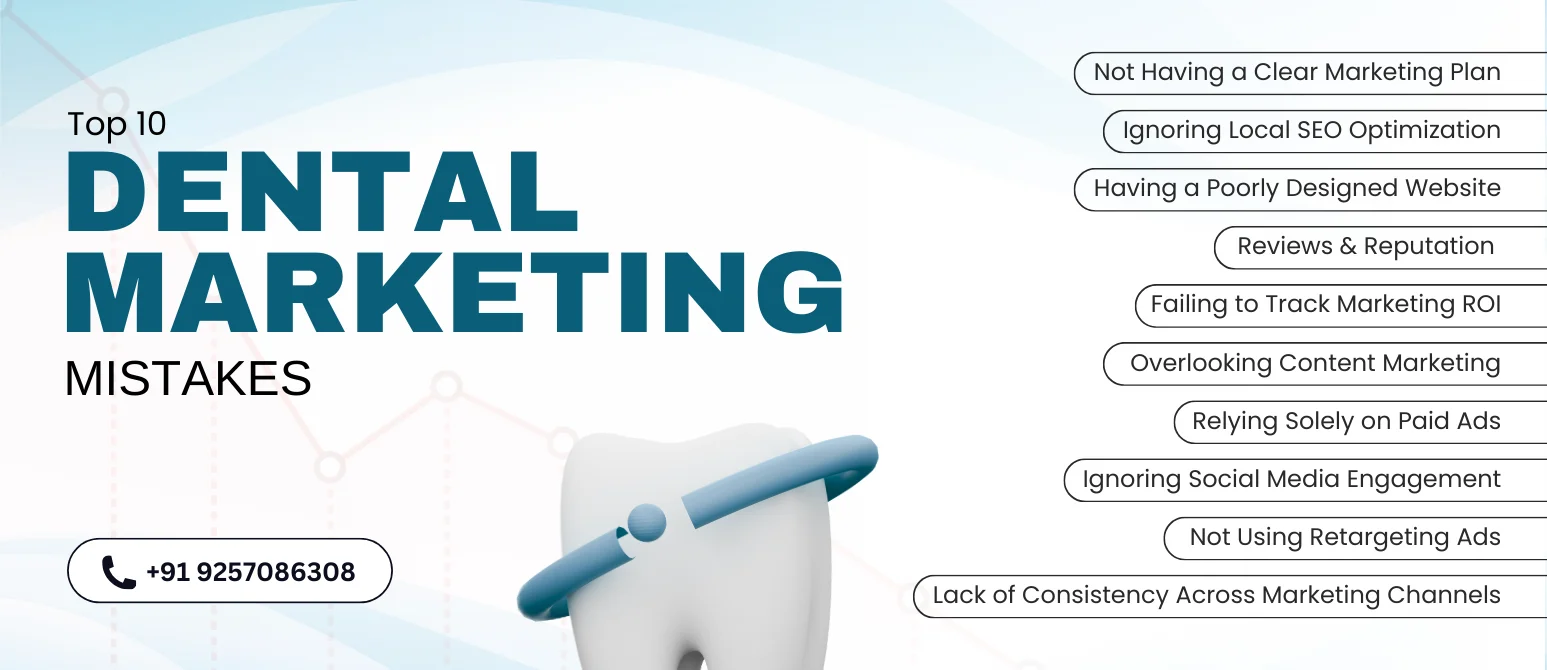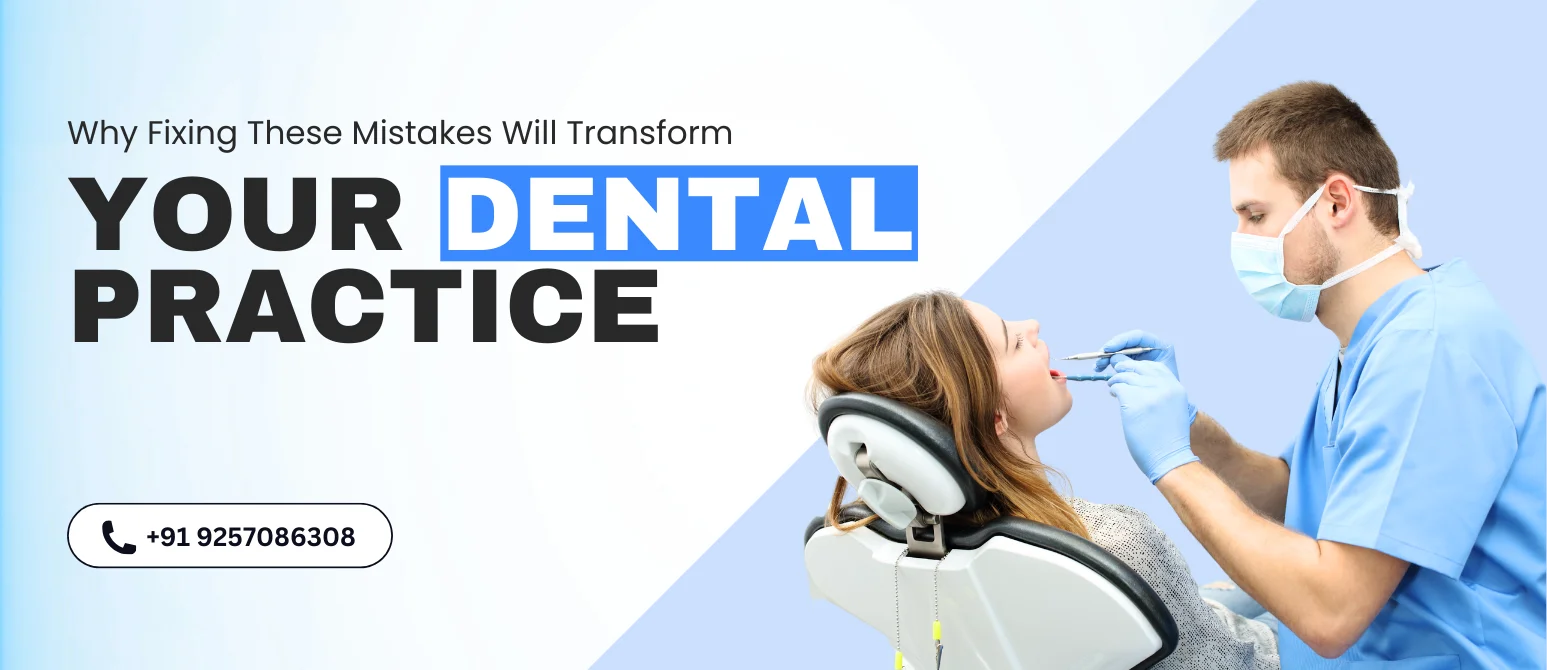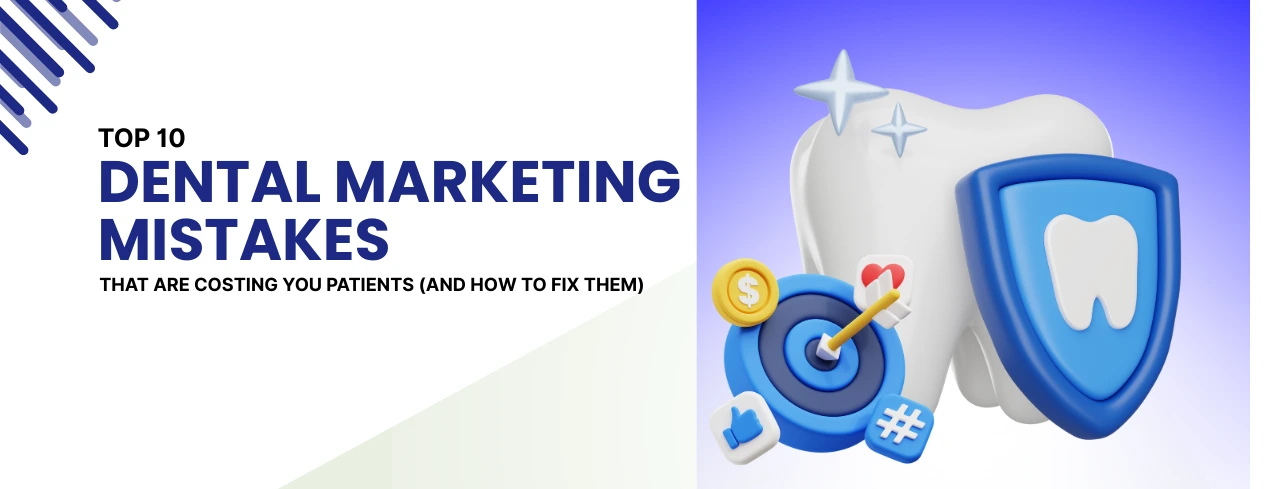In today’s hyper-competitive healthcare landscape, dental practices can no longer rely solely on clinical excellence to attract and retain patients. While quality care will always remain the backbone of success, it is your marketing strategy that determines how many new patients discover and choose your dental clinic. Unfortunately, many dentists unknowingly fall prey to common dental marketing mistakes that derail growth, waste valuable resources, and damage credibility in the eyes of potential patients.
The numbers speak for themselves. According to a 2024 BrightLocal Consumer Review Survey, 98% of consumers now read online reviews before deciding on a local dental service provider. Meanwhile, Statista reports that over 77% of patients search online before booking dental healthcare appointments, making digital visibility non-negotiable. In such an environment, ignoring structured digital marketing is equivalent to handing over your patients to competitors who are better equipped online.
From skipping Local SEO optimization to neglecting social media engagement or running ad campaigns without tracking ROI, these mistakes not only stunt growth but also weaken long-term patient trust. The good news? Every error can be fixed with the right strategy. By identifying what’s holding your clinic back and applying corrective action, you can transform your marketing efforts into a powerful patient acquisition engine.
In this detailed guide, we’ll uncover the top 10 dental marketing mistakes most clinics make and, more importantly, how to fix them with practical, data-driven strategies. By the end, you’ll have a roadmap to align your marketing efforts, strengthen your digital presence, and consistently convert online visibility into loyal, long-term patients.
Table of Contents
Top 10 Dental Marketing Mistakes

Mistake 1: Not Having a Clear Marketing Plan
One of the most common dental marketing mistakes clinics make is diving into marketing without a structured plan. Many dentists post randomly on social media, run occasional ads, or publish sporadic blogs without tying these efforts back to measurable goals. The result? Scattered efforts, wasted budgets, and little to no growth in new patient appointments.
Think of it this way: running your dental clinic without a marketing plan is like performing a root canal without X-rays; you’re working blindly. A clear marketing plan provides direction, consistency, and benchmarks for success. It ensures that every rupee spent on ads, every blog written, and every social media post published contributes directly to patient acquisition and brand trust.
Why This Mistake Hurts Clinics?
- Wasted Budgets: Without clear goals, ad campaigns often target the wrong audience.
- Inconsistent Branding: Patients see mixed messages across different platforms, reducing trust.
- No Way to Measure Success: Without KPIs, you don’t know if your strategies are working.
- Low Patient Retention: Scattered strategies focus only on visibility, not on building long-term loyalty.
To avoid this pitfall, create a comprehensive dental marketing plan that includes:
- Defined Goals: Are you trying to increase new patient appointments, boost cosmetic dentistry leads, or improve retention rates?
- Target Audience Personas: Know whether you’re targeting young professionals, parents, or seniors, and tailor content accordingly.
- Channel Selection: Focus on platforms where your patients are most active (e.g., Google for Local SEO, Instagram for visual content, WhatsApp for reminders).
- KPIs to Measure Success: Track metrics like cost per lead, website conversion rate, and patient acquisition cost.
According to a HubSpot 2024 Marketing Strategy Report, businesses with a documented marketing plan are 313% more likely to achieve their goals than those without one.
Mistake 2: Ignoring Local SEO Optimization
Neglecting Local SEO is one of the most damaging dental marketing mistakes clinics can make. In 2025, when over 77% of patients search online before booking dental services, local visibility isn’t optional; it’s mission-critical. A dental practice unseen in local searches becomes invisible to potential patients right when they’re most likely to convert.
Why This Mistake Holds You Back
- Missed Visibility: If your Google Business Profile (GBP) is under-optimized, your clinic won’t appear in search results when locals search for services like “dentist near me,” losing visibility to competitors instead.
- Lost Patient Opportunities: Local SEO targets high-intent patients precisely when they’re looking for care, meaning better visibility can directly translate to more appointment bookings.
- Weak Competitive Stance: A properly optimized local presence helps you stand out in your community, especially against larger dental groups with bigger marketing budgets.
The Fix: Local SEO Done Right
- Claim & Optimize Your Google Business Profile (GBP)
Complete and consistently update your GBP with accurate NAP details, strong category choices, and compelling descriptions. - Build Quality Local Citations
Ensure your clinic’s name, address, and phone number are consistent across reputable directories like JustDial, Practo, Sulekha, and local healthcare listings. - Create Location-Specific Service Pages
Optimize location-based pages such as “Teeth Whitening in [Your City]” with localized content and keywords. Google prioritizes these for local relevance. - Leverage Structured Data / Schema Markup
Implement Local Business Schema to help search engines better understand and showcase your clinic details. - Encourage & Manage Reviews
A robust volume of positive reviews on GBP enhances social proof and improves your chances of landing in the Local Pack.
Real-World Example
Promodo notes that local SEO is one of the most cost-effective strategies to consistently attract patients “when done right.”
At DQOT Solutions, local SEO optimization has repeatedly shown success. Clinics featuring properly managed GBP, structured service pages, and frequent review generation have seen a marked increase in both web traffic and patient acquisition.
Mistake 3: Having a Poorly Designed Website
A website that looks dated, loads slowly, or isn’t mobile-responsive isn’t just unappealing; it actively drives patients away before they even reach out. In today’s digital-first patient journey, your dental clinic’s website serves as your welcome desk. If it stumbles from the start, opportunity slips right through your fingers.
Why a Poor Website Hurts Your Clinic?
- Immediate Bounce: Over 50% of users abandon sites that take more than 3 seconds to load.
- Mobile Neglect is Costly: With 70% of dental website traffic coming from mobile devices, a non-responsive design harms visibility and usability.
- Trust Damage: According to a recent report, 62% of users ignore businesses without an online presence, meaning an underwhelming website may as well be invisible.
How to Fix a Poor Website Design
- Implement Mobile-First Design
Opt for responsive layouts that adapt across devices. Include thumb-friendly buttons, visible CTAs, and readable text. Google now prioritizes mobile versions of sites when ranking. - Optimize Load Times
Compress large images and videos, update plugins, and switch to faster hosting. Reducing load time by even a second dramatically reduces bounce rates and improves your SEO. - Craft Clear Navigation & Strong CTAs
Your menu should guide visitors to key services, like “Book Now” or “Contact Us”, in one click. Clarity in navigation is conversion gold. - Use High-Quality, Original Visuals
Professional imagery and videos build credibility. Avoid generic stock photos—they dilute trust. - Showcase Conversion-Optimized Elements
Display patient success stories, before-and-after visuals, live chat options, and real-time appointment widgets to drive action.
Real Design Benefits for Dental Clinics
According to Smile Marketing, mobile-friendly websites not only boost rankings but also patient conversions, keeping visitors engaged and prompting real actions. Similarly, 29% of patients evaluate a clinic’s credibility based on its website’s study design and usability.
At DQOT Solutions, our approach ensures your website feels fast, looks modern, and converts. Since 2020, our clients have reported a 70-150% jump in online appointment bookings just by revamping their web design and UX structure.
Mistake 4: Neglecting Online Reviews and Reputation Management
Ignoring online reviews is one of the most critical dental marketing mistakes a clinic can make in 2025. Reviews go beyond mere feedback; they’re a digital handshake. Nearly half of potential patients, 48%, research dental professionals online before booking an appointment, and 71% search online first when seeking dental care.
Managing your reputation isn’t optional; it’s essential for trust, visibility, and patient acquisition.
Why This Mistake Is Costly
- Trust Factor: A staggering 84% of consumers trust online reviews almost as much as personal recommendations.
- Review Influence: Google search rankings and trust are heavily influenced by your star rating and volume of authentic reviews.
- Engagement Value: 88% of patients prefer a dentist who actively responds to reviews, positive or negative.
A lackluster online reputation can lead to lost patients, diminished credibility, and reduced performance in both organic and paid search.
The Fix: Proactive Reputation Management
- Promptly Request Reviews from Happy Patients
Make it part of your process. Share your Google Business Profile (GBP) link via email or post-appointment SMS and gently ask satisfied patients to leave feedback. - Respond to All Reviews with Tact and Compliance
Personal yet professional responses (without disclosing patient details) make a strong impression. According to ADA research, while 39% of dentists can’t respond due to HIPAA, thoughtful replies still build credibility. - Showcase Reviews Transparently on Your Site
Featuring recent, unfiltered reviews directly on your website signals authenticity and confidence. High review counts and visible star ratings also boost SEO visibility. - Monitor and Audit Review Platforms
Regularly check GBP, Facebook, and local directories. Tools can help aggregate comments and streamline your reply workflow. - Leverage AI-Powered Reputation Tools
Emerging AI tools can help identify high-impact negative feedback and suggest response strategies. This keeps your communication both timely and strategic.
Mistake 5: Failing to Track Marketing ROI
Many dental clinics fall into the trap of investing in marketing—whether ads, content, or promotions—without accurately tracking how these efforts translate into patient bookings or revenue. That’s one of the most costly dental marketing mistakes because it can mask ineffective spend and overlook high-performing channels.
Why Not Tracking ROI Is a Big Deal?
- Budget Bleed: Without tracking, you can’t identify which campaigns deliver real results or where money is going to waste.
- Blind Strategy Adjustments: No data means you’re flying blind—promoting blindly budget shifts or channel changes without knowing what truly works.
- Missed Growth Signals: Tools like Google Analytics, call tracking, and CRM insights reveal how potential patients behave and convert—but only if you’re measuring.
The Fix: Build a Data-Driven ROI Tracking System
- Set Clear, Marketing-Aligned Goals
Define measurable objectives such as:
- New patient appointments (volume)
- Cost per acquisition (CPA)
- Patient lifetime value (LTV)
- Monitor Essential KPIs
Track meaningful metrics:
- Website traffic sources
- Lead-to-patient conversion
- Cost per leading source
- Overall patient LTV
- Use the Right Tools
- Google Analytics: Set conversion goals and monitor user paths.
- Call Tracking: Attribute calls to specific campaigns.
- CRM Integration: Tie patient bookings back to marketing touchpoints.
- Calculate Short-Term vs. Long-Term ROI
- Short-term ROI: Immediate return from campaigns.
- Long-term ROI: Includes ongoing patient revenue and referrals.
- Use ROI Dashboards
- Visual dashboards that pull in ad spend, calls, web leads, and patient data give you real-time insight and help you focus on what’s working.
Example Scenario: The Math Behind ROI
Suppose a clinic invests ₹50,000 in Google Ads and acquires 10 new patients from those ads, generating ₹2,00,000 in treatment revenue:
- Short-term ROI: ((₹2,00,000 – ₹50,000) ÷ ₹50,000) × 100 = 300%
- Long-term ROI: Include patient referrals and lifecycle value for a more expansive view.
Top-tier clinics can generate ROI multiples of 30x–80x when factoring in patient lifetime value (LTV) and referrals.
Why Tracking with DQOT Solutions Makes a Difference?
- Clients receive custom ROI dashboards that combine web, call, and patient data.
- Weekly campaign insights: Know instantly which ads or strategies are driving appointments.
- Real-time optimization: Adjust ad budgets, tweak underperforming campaigns, and amplify high-performing ones for sustained growth.
- Long-term ROI planning ensures you’re not just capturing patients today, but generating revenue and referrals tomorrow.
Mistake 6: Overlooking Content Marketing
In 2025, skipping content marketing is a critical oversight for dental clinics. It’s one of the most impactful dental marketing mistakes that quietly erodes patient trust, visibility, and long-term growth.
Content isn’t just messaging; it’s how you educate, engage, and build credibility. When executed well, content builds a bond with current and future patients, boosting awareness and driving organic traffic.
Why Ignoring Content Marketing Holds Clinics Back?
- Trust & Authority Gap: Without informative blogs, videos, or visuals, your clinic misses chances to position itself as an expert, leaving patients uncertain and less likely to book.
- Lower SEO Visibility: Content optimized with relevant keywords improves search rankings, making it easier for patients to find you organically.
- Missed Patient Engagement: Content that addresses anxiety or procedural FAQs builds emotional connections and loyalty, even before your patients step inside.
- Higher Costs in the Long Run: Unlike ads, great content has long-term value, continuing to attract new patients without ongoing spend.
The Fix: Build a Content Strategy That Converts
- Define Clear Goals & Patient Personas
Map out who you’re writing for, working professionals with sensitivity around dental anxiety? Parents looking for pediatric dentists? Tailor your content to their needs. - Diversify Your Content Formats
Use blogs for in-depth explanations, videos for procedural walkthroughs, FAQs for search visibility, and infographics for easy comprehension. This variety ensures you reach different audience segments and consumption preferences. - Localize Your Content
Publish content that ties dental care to your community or region—such as “Winter Oral Care Tips for Bangalore in 2025” or local event participation stories. - Maintain a Content Calendar
Plan regularly, weekly or biweekly. Consistency builds SEO momentum and keeps patient engagement steady. - Measure and Refine
Use web analytics to track which topics drive traffic or conversions. Keep refining—double down on engaging content and remix evergreen themes.
Real Results Speak Volumes
- According to mConsent, clinics that consistently share educational and relevant content see greater patient trust, improved website traffic, and more new patient inquiries.
- Remedo’s insights further confirm that content helps clinics build reputation, boost visibility without heavy ad spend, and foster patient loyalty.
Mistake 7: Relying Solely on Paid Ads
Putting all your marketing eggs in the paid ads basket is a strategy fraught with pitfalls, especially in the competitive world of dental marketing. While paid ads offer speed and precision, treating them as the only channel is one of the biggest dental marketing mistakes a clinic can make.
Why Overdependence on Paid Ads Backfires
- High Cost & Fragile ROI: Paid campaigns can deliver results quickly, but costs rise fast without sustainable traction. As noted by The eDigital, while PPC can generate immediate visibility, it comes at a cost—once the budget stops, so do the results.
- Unbalanced Marketing Mix: Dental Implant Machine found that organic lead generation often delivers a higher ROI than paid campaigns, emphasizing long-term growth over immediate but fleeting ad clicks.
- Short Shelf Life: Unlike SEO, which builds lasting visibility, paid ads vanish the moment they’re turned off. The eDigital articulates this well: Paid ads are a faucet—turn it off, and leads stop flowing.
- Budget Leak through Poor Execution: A Remedo report reveals that nearly 75% of Google Ads budgets are wasted due to poor keyword targeting, ineffective ad copy, and improper bid strategies.
The Fix: Balance Paid Ads with Organic Foundations
- Invest in Organic SEO for Sustainable Growth
Strengthen your online presence with content marketing, local SEO, and structured site optimizations. As Now Media Group highlights, SEO offers long-term visibility, cost-efficiency, and enhanced credibility, ideal for consistent patient acquisition. - Use Paid Ads Strategically, Not Exclusively
Deploy ads for strategic bursts, new service launches, promotional blitzes, or quick spikes in visibility. Back these efforts with SEO and content to sustain momentum over time. - Target Smartly and Optimize Continuously
Hone your PPC using geo-targeting, negative keywords, and performance tracking. Reddit marketing veterans recommend securing precise targeting within your service radius and monitoring conversions closely. - Combine Retargeting with Brand Building
Paid ads can re-engage visitors who didn’t convert initially when combined with organic touchpoints like educational content and patient testimonials. This hybrid strategy boosts both efficiency and trust.
Mistake 8: Ignoring Social Media Engagement
Simply posting promotional content on social media without engaging with your audience is ineffective. Social media is about building relationships, not just broadcasting services.
The Rising Impact of Engagement
- Patients Simplify Their Research: Around 40% of patients consult social media before making dental decisions, and 72% of dentists already use social media to promote their practices.
- Engagement Builds Trust: Practices that publish authentic, personality-driven content experience 67% higher engagement compared to ones that only push promotions.
- Top-of-Mind Visibility: Posting consistently, even just 3–5 times a week, can improve brand recall by 33%, positioning your clinic as a trusted option.
Common Pitfalls That Block Engagement
- Posting Without Strategy: Sharing content without context or audience focus leads to low interaction and growth stagnation.
- Lack of Personal Connection: Treating social media like a billboard misses the opportunity to humanize your team and clinic experience.
- Minimal Interaction: Failing to respond to comments, messages, or user-generated content turns engagement into a one-way street.
The Fix: Encourage Engagement Through Authentic Content
- Humanize Your Practice
- Share behind-the-scenes posts, team spotlights, and candid office moments to make your clinic feel accessible and welcoming.
- Mix Content Formats for Max Impact
- Create educational content, community event highlights, patient stories, and light-hearted posts like holiday-themed jokes or polls.
- Leverage video formats, live Q&As, treatment walkthroughs, or short reels that demystify dental concerns. Videos generate significantly more engagement.
- Run Contests to Spark Interaction
- Fun contests like “Smile Selfie” challenges or caption contests give your followers a reason to engage and support a deeper connection.
- Be Responsive
- Reply to comments, direct messages, and mentions promptly. Engagement fosters trust and pushes your content into broader visibility.
- Local Collaborations & Community Involvement
- Partner with local businesses or spotlight community campaigns to broaden your reach in the geographic areas you serve.
Mistake 9: Not Using Retargeting Ads
Retargeting ads, also known as remarketing, are vital tools that bring back visitors who showed interest in your dental services but left without booking an appointment. Surprisingly, among the most costly dental marketing mistakes is simply overlooking this powerful strategy.
Why Retargeting Ads Are Essential?
- Most visitors leave without converting: Studies show that 97% of first-time website visitors leave without taking any action, making retargeting an essential step to re-engage them.
- Higher conversion rates: Retargeting targets “warm leads,” meaning visitors already familiar with your clinic, which dramatically increases the chance of conversion and provides better return on ad spend.
- Cost-effective patient acquisition: Since the audience is already interested in your services, retargeting ads tend to be more affordable compared to broad campaigns.
- Drives brand recall: Regular exposure via ads keeps your clinic top of mind for prospective patients who haven’t decided yet.
The Fix: Strategically Implement Retargeting Campaigns
To convert more visitors into patients, follow these steps:
- Define Target Segments
Identify audiences like visitors who browsed services but didn’t book, those who abandoned booking midway, or past patients who haven’t visited in a while. - Choose the Right Platforms
Use both Google Ads (for search and display reach) and social platforms like Facebook/Instagram for immersive ad formats. - Set Up Tracking Pixels
Install retargeting pixels from platforms like Meta and Google on key website pages to track visitor behavior accurately. - Craft Personalized Ad Messaging
Tailor your ads to specific visitor behaviors. For instance, promote Invisalign to those who viewed that service page or offer a limited-time consultation to abandoned booking users. - Respect Privacy & Frequency
While retargeting is impactful, it’s key to balance frequency to avoid ad fatigue or privacy concerns. Be transparent and compliant with data collection policies.
Real-World Impact
Retargeting campaigns consistently boost engagement and conversion ratios by reminding patients of the services they considered, moving them closer to booking. Dental marketers estimate that consumers are up to 70% more likely to complete a purchase when retargeted.
Mistake 10: Lack of Consistency Across Marketing Channels
One of the most overlooked dental marketing mistakes is inconsistency across platforms. Many clinics put effort into one channel, say, Instagram or Google Ads, while neglecting others, leading to a fragmented brand presence. Patients today interact with your dental clinic on multiple touchpoints: your website, Google Business Profile, Facebook, Instagram, email newsletters, and even offline advertisements. If the tone, visuals, or messaging feel disjointed, trust erodes quickly.
Why Consistency Matters?
- Builds Brand Recognition
Patients are more likely to remember and trust clinics that present a unified identity. Consistent branding ensures your dental practice is instantly recognizable across platforms. - Increases Patient Trust
When your Google Business Profile says one thing and your website says another (like different hours or phone numbers), it confuses patients and signals unreliability. - Boosts SEO and Conversions
Consistent NAP (Name, Address, Phone Number) across citations improves local SEO rankings, while aligned calls-to-action across channels increase conversion rates. - Reduces Marketing Waste
Fragmented branding forces clinics to spend more on ads and promotions to build recognition from scratch every time. A cohesive strategy stretches your marketing budget further.
The Fix: Create a Unified Marketing Ecosystem
Here’s how to fix inconsistency and build a seamless patient journey:
- Standardize Your Branding
- Use the same logo, fonts, and color palette across the website, social media, and ads.
- Develop brand guidelines to ensure all marketing materials feel cohesive.
- Align Messaging Across Platforms
- Keep your clinic’s tone of voice consistent, whether it’s professional, empathetic, or approachable.
- Ensure promotions and offers are updated across all channels simultaneously.
- Ensure NAP Consistency
- Audit every online listing (Google, JustDial, Practo, directories).
- Correct discrepancies in address, phone numbers, or business hours.
- Cross-Channel Integration
- Drive traffic from social media to a landing page optimized for conversions.
- Connect email marketing with retargeting campaigns for a cohesive patient journey.
- Maintain Posting Regularity
- Use scheduling tools to maintain a steady presence. Irregular posting signals inactivity, discouraging potential patients.
Why DQOT Solutions Is the Answer
At DQOT Solutions, we specialize in creating a consistent, omnichannel marketing presence for dental practices. From ensuring your NAP is flawless across directories to aligning your website, ads, and social content with one brand voice, we make sure patients see a unified clinic story at every touchpoint. Our frameworks remove confusion, build trust, and drive more booked appointments with less wasted effort.
Why Fixing These Mistakes Will Transform Your Dental Practice

Correcting these dental marketing mistakes is about transforming the way patients perceive, engage with, and trust your dental clinic. Every error, from ignoring local SEO to inconsistent branding, represents a leak in your patient acquisition funnel. By systematically fixing them, you create a seamless journey where potential patients move from discovery to booking without friction.
How Does Fixing Mistakes Impact Growth?
- Increased Visibility
Addressing SEO issues ensures your clinic ranks higher on Google. For instance, dental clinics that invest in proper local SEO see up to 70% more foot traffic from local searches within six months. - Higher Patient Trust & Conversions
Managing online reviews and maintaining consistency across platforms directly improves credibility. According to a 2024 survey, 88% of patients trust online reviews as much as personal recommendations. A trustworthy online presence converts casual browsers into booked appointments. - Optimized Marketing Spend
Tracking ROI and fixing inefficiencies reduces wasted ad budgets. Dental clinics that monitor conversions and retarget website visitors often see 25-40% higher ROI on paid campaigns. - Stronger Patient Relationships
Content marketing, social engagement, and reputation management humanize your dental clinic. Patients feel more connected to practices that not only treat but also educate and engage. - Sustainable Long-Term Growth
While paid ads deliver quick results, fixing foundational mistakes like poor website design, lack of SEO, and inconsistent branding ensures long-term patient acquisition without dependency on high ad spends.
A Real-World Transformation
Take the example of Dr. Ritu’s dental clinic in Pune. Despite excellent services, her clinic struggled with new patient acquisition. An audit revealed:
- Outdated website with no online booking.
- Inconsistent NAP across directories.
- No structured review strategy.
- Heavy reliance on paid ads with no content marketing.
After fixing these mistakes with the help of DQOT Solutions, including a website redesign, local SEO optimization, a review generation campaign, and social media engagement, the clinic saw:
- 3x increase in organic website traffic within 4 months.
- 50+ new patient bookings per month from Google Business Profile.
- A reduction in ad spend by 30%, while increasing ROI.
Her practice now enjoys steady, predictable growth with a digital presence that reflects the quality of her care.
Partner with Experts Who Understand Dental Marketing

Fixing these mistakes requires expertise and a deep understanding of the dental industry. That’s where DQOT Solutions steps in. As a leading dental marketing and website design company, we specialize in helping dental clinics eliminate these costly mistakes and replace them with data-driven strategies that deliver real results. From SEO and content marketing to ad campaigns and social media engagement, our solutions are tailored to the unique challenges and goals of dental practices.
Ready to stop losing patients to avoidable mistakes and start building unstoppable growth? Get in touch with DQOT Solutions today for a personalized marketing audit and discover how we can transform your dental clinic into the most trusted dental brand in your city.
Final Thoughts
In 2025, the difference between a thriving dental clinic and one struggling to attract new patients often comes down to marketing precision. The most common dental marketing mistakes, from neglecting local SEO to running ad campaigns without tracking ROI, are silent growth killers. The good news? They’re all fixable.
When you align your marketing strategy with patient expectations, every touchpoint, from Google searches, website visits, social media interactions, to online reviews, becomes a stepping stone toward building trust and driving appointments. Patients no longer choose the dentist with just the best dental clinic setup; they choose the one who shows up consistently, communicates clearly, and earns their confidence online.
By avoiding these pitfalls and implementing the fixes we discussed, your clinic can:
- Increase visibility in local searches and Google’s 3-Pack.
- Convert more patients with a professional, patient-friendly website.
- Build credibility through authentic reviews and consistent branding.
- Maximize ROI by tracking, refining, and balancing paid + organic strategies.
- Future-proof your clinic with a long-term growth strategy that adapts to digital trends.
FAQs: What Dentists Want to Know About Marketing Success
Focus on data-driven strategies by defining what success looks like for your clinic, be it appointment bookings, search visibility, or consultations scheduled, and track metrics using tools such as Google Analytics, Facebook Pixel, and call tracking. Identifying underperforming channels and reallocating your budget accordingly maximizes ROI and minimizes waste.
If consistent efforts aren’t converting, check for clear targeting. Are you speaking directly to your ideal patient, families, cosmetic dentistry clients, or emergency cases? Avoid broad messaging and align your platforms and tone with the people you genuinely want to serve.
Not necessarily. It’s better to focus on platforms where your ideal patients spend time, like Instagram for cosmetic dentistry or Facebook for family audiences, and engage authentically there rather than being spread thin across all channels.
Ignoring negative reviews, or worse, not responding at all, is a big missed opportunity. A timely, empathetic response can improve trust, show accountability, and sometimes even turn a negative into a positive.
Marketing needs consistency and patience. For example, SEO and content-driven strategies often take 3-6 months to gain traction but build sustainable results. Avoid the pitfall of switching strategies too quickly before seeing real progress.







